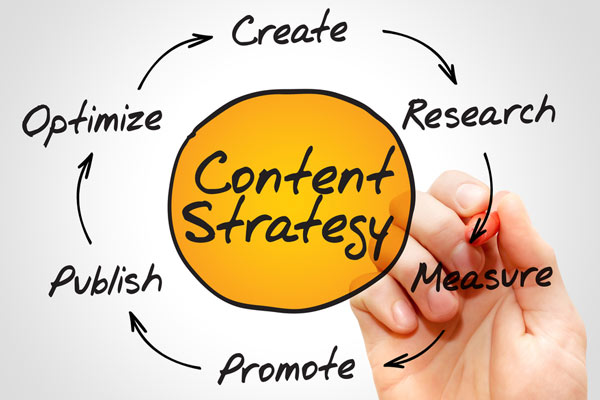This article is part of a series on web content development. To start at the beginning, check out “Introduction to Web Content Development.”
We’ve already talked about how to lay the groundwork for your web content development by brainstorming. You jotted down your ideas, conducted research, and expanded on those ideas. You looked at the competition and learned what your industry is doing in the online marketplace. You took notes and made lists. You asked questions and came up with answers.
You went in empty handed and came out with a better understanding of what your online presence should look like.
Now that you’re done brainstorming, you should have plenty of ideas for your web content development plan. Maybe you’ve got it scrawled on a bunch scrap paper. Perhaps you used an orderly mind-mapping technique or created a PowerPoint presentation.
Take a look at your notes. Those are the seeds you’ve gathered. Now you need to plant those seeds and make them grow. You have to water and fertilize them, and make sure those seedlings get plenty of sunshine. To do this, you’re going to need a plan: a web content development plan.
The Benefits of Having a Plan
I’m a big fan of planning. If you spend a little time on a plan right now, you can save loads of time later. A good plan will help you avoid mistakes because as you build your plan, you’ll naturally contemplate various possibilities and scenarios. You’ll be able to work contingencies into the plan, as well as emergency exits and the notorious plan B.
Running a business is not easy. It takes a lot of time and energy, especially when you’re just starting out or going through a renovation or expansion. If you don’t write a plan, then you might get caught up in your day-to-day business activities and forget all about the evolution of your online presence. This is especially true if you have a long-term business plan (please tell me you do).
A plan also provides you with a blueprint. There are infinite possibilities on the web and it’s easy to get lost among all the opportunities. If you have a plan, you’ll be able to navigate through your many choices with ease and confidence.
Tips for Web Content Development Planning
Purpose and Priority
I believe that all good plans start with a sense of purpose and priority. Let’s say your first web project will be to redesign your website. You decide to scrap all three or four pages of written content because they are outdated, and you want to get rid of the layout, which is just dated. But you’d like to keep your logo. You decide you need about twenty pages of content, including one page for each product you sell. You also want to get set up on popular social media networks. You’d like to use video as well. You’ve got a big list of big ideas, and you can’t wait to see them come alive.
But first you need to step back and decide what matters most. This is how you organize and put things in order: Your website is more important than social media. Your email marketing campaign is more important than your hopes for creating a viral video. Later, we’ll talk about contingencies, timelines, and budgets. But for now, keep in mind that no matter how hard we work or how carefully we plan, things change. You might get a golden opportunity in a few months and have to postpone some of your content development plans for lack of time (being busy is good, right!). You might have a difficult quarter and have to tighten the budget. You never know what the future holds. So dream big, but then put your dreams in order.
When you’re dealing with a website, for example, you should definitely give your core pages greater priority. These include your home page, about page, products or services page, and contact page. Four simple pages that every business website should have. Viral videos are all the rage, but millions of people post videos every day, and there’s no guarantee that yours is going to be a phenomenon. A more reliable marketing strategy should come first. Put things in their proper order. Prioritize, and everything else will follow.
Flexibility
Nothing stresses me out more than a plan that has no flexibility built in. Let’s say you’re a middle manager. You have to get a project to your boss by Friday. Please don’t tell your subordinates that it’s due Friday. You tell them it’s due Thursday. Or better, Wednesday. That gives you some leeway in case anything goes wrong. And things do go wrong. Next year, your budget might be twice what it is this year (or it could be half). Even the very best plans, the ones that are perfectly executed, are subject to reality. And in reality, stuff happens. Unpredictable stuff. So create your plan, but don’t create it out of iron or chisel it into stone. And remember, technology is changing all the time. Be prepared, because this year’s blog is next year’s Twitter, and who knows what we’ll be dealing with the year after that?
Timeline
A website doesn’t happen overnight. If you’re starting a brand new business, you’ll want the completion of your website to coincide with the launch of the business itself. If you’re doing a redesign and want to time it with a product or service launch, you’ll need to coordinate your timelines.
The biggest mistake I see small business owners making in the online world is not having any plan at all. The second biggest mistake is no timeline. They’re going to start publishing a newsletter, but when? They’ll update their online profiles, eventually. They’d like to add fresh content to the site. Someday.
Lots of people don’t like committing to a timeline. Well, that’s what flexibility is for. At least with a timeline, you can make some sound guesses about the future of your web content. At the very least, you can create a series of events and ascertain how long each will take and how much time you need between each one. For example, you can allot six weeks to creating a website. You might need two weeks to create an email marketing campaign. You don’t have to glue these projects to the calendar, but you can use a timeline to better understand how long everything will take. This will enable you to align various facets of your entire business.
Budgeting
Smart businesspeople know how to budget. But we just talked about flexibility and the unforeseeable future. The fact that you cannot know for sure what the future holds also means you can’t know for sure what your budget will be in later months or years. The economy is unpredictable, the market is unpredictable, and consumers are getting more fickle by the minute. Hopefully, you’ll have a bigger budget than you hoped for. But we all know how many businesses fail every year (if you don’t know, the answer is this: the vast majority!). And when disappointment comes knocking, the first thing that shrinks is your budget. Some businesses can avoid failure by having a flexible budget, or rather, by having a plan that’s flexible enough to adapt to a changing budget.
You should, however, budget for online marketing on a long-term basis. A lot of small businesses throw a few hundred dollars at a website and then forget about it. Three years later, they remember they have a website and they pay a few hundred more dollars to update it. This is not a healthy cycle. It could be costing the business customers, who are apt to think that if the website is half-baked, the company probably is too. Make sure you have a regular, ongoing budget for online marketing and website maintenance.
Contingencies
A contingency is something that might happen, but there’s no guarantee. It’s a what-if. As someone who’s curious by nature, I’m thrilled by what-ifs. It’s also what keeps me up at night. What if the video really does go viral? What if nobody responds to my Facebook page? What if the site becomes an overnight sensation; do I have the resources to handle the new business that the site could attract?
When you’re writing a plan, you should include contingencies. You probably don’t need a lot of them, but contingencies work alongside flexibility. In your plan, you believe that if you build a site and launch a proper marketing campaign, you should be able to increase your current sales by 20%. So you build the site, but it’s drawing more customers than you anticipated. Will you be ready to handle the new business that’s coming in?
Plan B
If your plan doesn’t pan out the way you intended, what are you going to do? Nobody likes thinking about worst-case scenarios, but this is business and the reality is that success is not guaranteed. However, you can minimize your losses by having a solid backup plan in place. And you never know, a good backup plan might lead to another (and more beneficial) opportunity. Let’s say you’re just out of college and want to be a freelance graphic designer. You set up a website and start hustling online. You do okay, but not great. Your designs are awesome, but sales isn’t your thing. A year in, you’ve invested a lot of time and money building your little business. But now, you’re not sure you’re in it for the long haul.
Secondary plans abound in situations like this. You can rework your website, turn it into an online resume and portfolio, and then use it find a regular job (you can always continue freelancing on the side). You can find a partner who specializes in sales and work together to grow the business. You can sell your site (aged websites have value, and aged sites with decent content have even more value — high traffic sites are worth a lot) and get out of the business altogether.
Yes, it sucks when things don’t work out the way we’d hoped. But it’s not the end of the world. If you have a plan B, you’ll be prepared, and you’ll get through any major disappointments just fine.
Get Ready to Execute
Planning takes time and effort, but it can prevent unnecessary hassles later. Take some time to brainstorm your vision for your online presence. Then turn that raw material into an organized plan, one that’s prioritized and has a clear budget, a tentative timeline, and a lot of flexibility built in. Include contingencies and a backup plan. Once you get through that planning phase, you’ll be ready to execute. It’s time to start building!
Next Phase: Building
Once your plan is complete, you are ready to enter the next phase: “Building Your Web Content.”
Buzz Pro Studio provides website services to small businesses and independent professionals, specializing in website design and maintenance. For more information or to get a no-obligation quote, contact me.
Melissa Donovan is the founder of Buzz Pro Studio, providing website services to small businesses and independent professionals.


